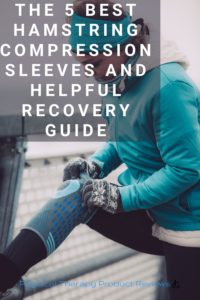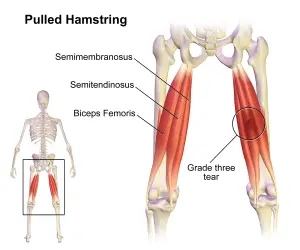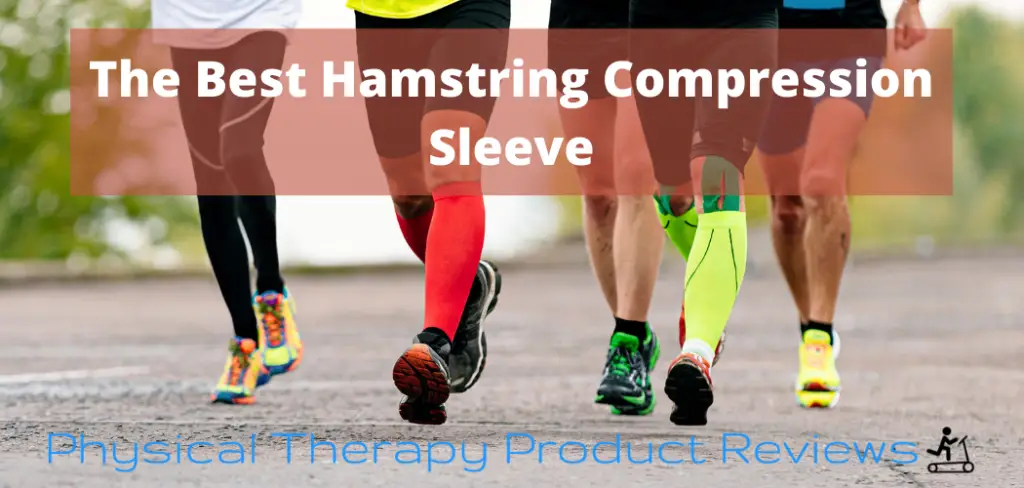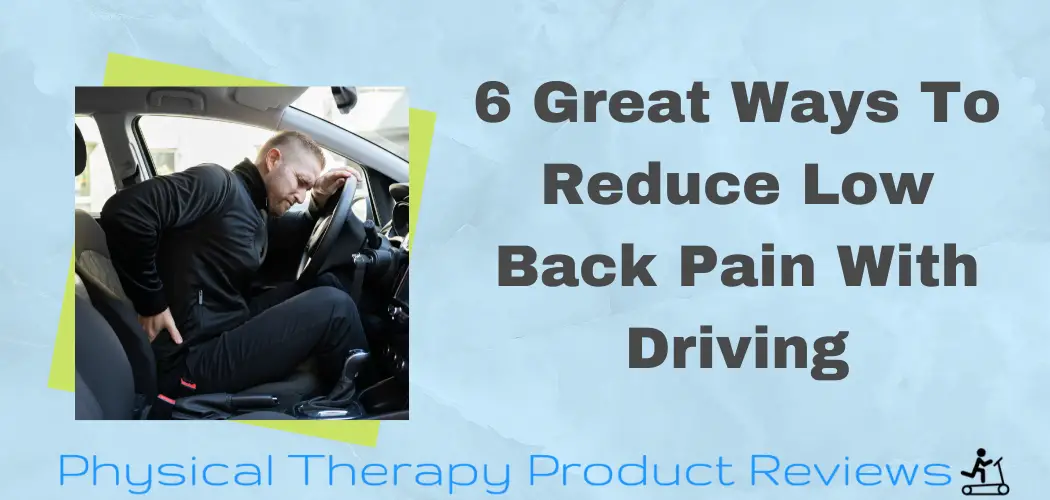 Compression garments are becoming more and more popular amongst both high level and recreational athletes.
Compression garments are becoming more and more popular amongst both high level and recreational athletes.
Full compression tights are commonly used in the NBA, compression socks are found in marathons and distance races across the country, and the new “in” dress attire in elementary school is full-length compression tights underneath athletic shorts.
Compression garments may be used for many different reasons including comfort, perceived performance improvement, reducing injury risk, and potential decrease in muscle soreness after competitions.
One of the most common injuries that cause runners and recreational athletes to miss time is hamstring strains.
Our favorite hamstring compression sleeve to aid in pain and recovery from hamstring strains is the Bauerfeind Compression Sleeve.
| Name | Picture | Price | Best Feature | Our rating | Best Price |
|---|---|---|---|---|---|
| Bauerfeind Thigh Compression Sleeve |
 |
$$ | Great Compression with Comfortable Material | 9.7/10 | See Current Price |
| Zensah Thigh Compression Sleeve |
 |
$ | Moisture wicking and odor-free fabric | 9.5/10 | See Current Price |
| Sparthos Thigh Compression Sleeve |
 |
$ | Lightweight and Comfortable | 9.5/10 | See Current Price |
| Shock Doctor Compression Sleeve |
 |
$ | More support and we love the material | 9.4/10 | See Current Price |
| Bioskin Thigh Compression Sleeve |
 |
$ | Does a Great Job of Staying in Place | 9.2/10 | See Current Price |
Hamstring Anatomy
The Hamstring group and be divided into two groups, the medial and the lateral group. The lateral group is comprised of the Biceps Femoris Long Head and the Biceps Femoris Short Head. The medial or inside group is comprised of the Semimembranosus and the Semitendinosus. (add links) The sciatic nerve lies in the middle of the groups and just deep to the muscles. Sometimes low back and Sciatica like symptoms may mimic hamstring strains in symptoms but usually have a different mechanism of injury.
More About the Hamstring Muscles

The Hamstring muscle group is made up of four muscles that lie on the back side of the thigh. 3 of the muscles are quite large and cross two joints (the hip and the knee) while 1 of the muscles only crosses the knee joint. By size the Hamstrings are one of the largest groups of muscles in the body and play a large role in not only athletics but maintaining our upright posture, walking, and sitting.
Hamstring strains, also called known as a “pulled hamstring” or a “tweaked hamstring” is fairly common in competitive athletes. In sports that require quick change of directions and sprinting they are more commonly injured. Hamstring injuries are classically a nagging injury and tend to linger long after they “feel normal.”
What Are Compression Sleeves
Compression garments were originally invented with the thought of improving athletic performance. The thought was that if you could prevent injury and recovery faster from an injury by using compression than those athletes would have the upper hand. Since the initial invention of compression garments some of those performance theories have yet to be proven by research. However here are some of the benefits from wearing compression garments.
Benefits of Compression Sleeves
- Improvement in blood circulation and muscle oxygenation (1)
- Blood Lactate Clearance (2)
- Muscle force Production (3)
- Jumping Performance (3)
- Improved muscular efficiency during running (4)
- Decreased landing and impact forces (5)
- Improvement in proprioception and body awareness during sport (6)
The improvement in the body’s awareness may not seem like a very important benefit but it may actually be the most important one. By being more aware of where our legs are in space and relative to the ground it may help us prevent more injury and overall “feel better” during athletic performance. This is particularly important with hamstring strains which are stretch with each running stride.
It is important to note there is not a consensus on the benefits of compression garments. For every positive research study there seems be a research study that shows no benefits. What that means is if you like them, go ahead and wear them. But if you don’t notice a difference that’s ok too.
How Compression Sleeves Work
How Compression Sleeves Help with Swelling
After an injury the body where there is tissue damage such as a strain, sprain, contusion from a contact injury, the body will begin to swell. Swelling is due to an increase in bodily fluid at or near the injured site. This is a mixture of blood, platelets, and other proteins within the body that will help the body heal itself. When there is too much swelling such as right after an injury, this can cause the valves in the vein to malfunction and for blood to flow backwards. This increased risk for blood clots, DVTs (yikes), stokes, and other serious medical complications.
Wearing a compression garment maintains the integrity of the one way valves within the veins and helps the body push the swelling back to the heart and rest of the body to be process. This prevents the back flow of blood and helps prevent any serious blood clots within the legs.
How Wearing Compression Sleeves Can Help with Pain
Increased swelling also irritate the nerves and cause pain. This can happen in two ways. First by increase the amount of fluid within a small space this may increase the pressure on the nerve which can increase the pain levels.
Secondly, inflammation has many different proteins and transmitters such as little guys called Cytokines which actually irritate nerve endings. By wearing compression should decrease the swelling induced pain and nerve irritation.
How Common are Hamstring Injuries
The occurrence of hamstring strains is actually quite high as compared to other injuries in recreation and professional sports. Verrall et al (7) reported that 30% of Australian football players in two clubs had posterior thigh pain over one season.
A review of the medical database of the National Football League (NFL) between 1987 and 2000 indicated that 10% of all injuries in American college football players likely to play in the NFL were hamstring strain injuries (8).
Even more concerning is that the incident of re-injury after a hamstring strain can be as high as 48% in some sports (9). Also, the second or the re-injury is often times more severe and causes more lost time and disability.
Grades of Hamstring Injuries
Grade 1 Hamstring Strain
The lowest level and the quickest to heal. With these injuries the muscle fibers are stretch and some of them may even be torn. Walking may difficult initially but within a few days things should go back to normal. There may be tenderness when touching the area.
Grade 2 Hamstring Strain
A more severe injury than a grade one. Walking may impacted and you may be limping for a few days up to a week. The area will be tender to the touch and there may be swelling and potential light bruising. It may be painful to bend the knee straight up when standing. This may take 3-6 weeks to fully heal.
Grade 3 Hamstring Strain
The most severe injury of the 3 which involves complete tearing of half or more of the muscle fibers. There will likely be a large bruise, swelling, and really tender to the touch. You may need crutches to walk and Physical Therapy is definitely recommended. This may take 6-12 weeks to fully heal depending on the severity and the activities of daily living after the injury.
Compression sleeves may help with all grades of Hamstrings strains, but especially with grade 2 and grade 3 strains. They may also help keep the swelling at a minimum.
The Best Exercises for a Hamstring Strain
Prescribing exercises for exercises for injuries when not being able to see them in person is difficult. When prescribing, there are a lot of variables such as the severity of the strain, the overall health of the person, the time since the initial etc.
The exercises listed below are for moderate Grade 2 and Grade 1 strains. When performing these exercises if the pain increases above a 4-5/10, then back off.
Hamstring Rehab Phase 1:
Supine Hamstring Stretch
This is to help lengthen and stretch the hamstring while preventing too much scar tissue from building up. Initially after an injury this should be done lighter and not trying to push into painful ranges. This should be performed 3x for at least 30 seconds.
Hamstring Isometric Holds
This exercise is to help the torn fibers be able to accept load. Start less than maximum strength and work up as you can tolerate. Isometrics also helps with decreasing pain levels and calming down the nervous system.
Seated Sciatic Nerve Glides
This exercise is designed to accomplish two goals. Lengthen the hamstring muscles and also calm down the sciatic nerve which can be irritated with the increased swelling in the area. The more the nervous system is calmed down the happier the muscles are going to be.
Hamstring Rehab Phase 2: Light Hamstring Loading
Hamstring Curls
This exercise make the hamstring muscle short under strain. This helps load the torn area safely to begin to get back to normal strength levels.
Hip Bridges
A great exercise that stabilizes the proximal attachment of the hamstring at the pelvis and making the injured hamstring fight gravity. This is one of the best exercises for low back, pelvis, and hamstring work.
Single-Leg Balance for Co-contraction
A functional exercise the causes the muscles of the hip, pelvis, and low back to all work together to keep us upright. Try this with both the hip and the knee slightly bent to make it harder and to hold for more than 30 seconds.
Hamstring Rehab Phase 3: Hamstring Strengthening Exercises
This phase is all about loading that tissue and getting it back to normal strength levels. We want to perform a lot of eccentric loading in this phase to:
- A) help remodel the tissue under tension
- B) strengthening the torn tissue while stretching it (eccentric loading)
- C) get it ready to perform at high levels again. Most of these should not be performed until 8-12 weeks after an injury depending on the severity of the strain.
Stability Ball Hamstring Curls
An exercise the looks hard and is hard. This is great for both concentric and eccentric loading. Perform a bridge on the ball and then roll the ball towards the body. The key part of this exercise is to SLOWLY roll the ball back to the starting spot.
Single Leg Deadlift
Another great exercise that loads the hamstrings eccentrically. Start by standing on two legs and “tipping” forward at the hips, NOT THE LOW BACK. This is made easier by pushing your hips backwards during the movement. Add weight or stand on a bosu ball (link) to make it harder.
Nordic Hamstring Curls
An absolute beast of an exercise and one that has gained a lot of popularity in recent weeks. This bar far the hardest exercise on the list and you may need to take is easy and modify initially. Start in a tall kneeling with a friend behind you holding your feet in place. Slowly lower your trunk forwards toward the ground in a controlled manner.
Hamstring Compression Sleeve Reviews
Bauerfeind Sports Thigh Compression Sleeve
Summary: An overall great thigh compression sleeve that can be used for many different reasons. It’s main benefits are the comfortable material, just the right amount of compression, and the overall ease of use of the sleeve.
Pro’s:
- Powerful Compression: The Bauerfeind compression sleeve provides great compression to the thigh muscles without being overly restrictive. This helps with pain reduction and overall proprioception of the thigh and leg muscles.
- Better Circulation: Improves venous flow back to the heart and maintains the tissue temperature which also increases blood flow.
- Swelling Management: After a hamstring strain this compression sleeve will help keep the inflammation at a minimum and aid with faster healing.
- 100% Guaranteed: Bauerfiend offers a 100% money back guarantee which is our favorite thing at PTPR. If it doesn’t work for any reason you can send it back, no questions asked.
Con’s:
- Measure Carefully: Not many complaints regarding this sleeve. It is usually user error is choosing the best size prior to ordering.
Zensah Thigh Compression Sleeve
Summary: Another great option to help with a Hamstring or quad strain. The silicone strips seem to work great for most, the material is really comfortable for a compression sleeve and it’s easy to use.
Pro’s:
- No Slip Silicone: This sleeve comes with a silicone grip on the upper thigh which prevents the sleeve from moving during activity. There is nothing more annoying than having to pull the compression sleeve back up the thigh thousands of times.
- Quality Material: Made in the USA from 75% Nylon/25% Spandex that makes it comfortable wear and it also has the ability to last for long periods fo use. The thigh sleeve is anti-odor and moisture Wicking – meaning it will stay smelling fresh and free of perspiration.
- Support: Provides the support that you need to help heal or prevent a hamstring injury from back. The compression does well maintaining during the duration of wearing the compression sleeve.
Con’s:
- Sizes: The main complaint for this sleeve is that there aren’t enough sizes, so if you fall between 2 sizes the sleeve may have a tendency to fall down.
Sparthos Thigh Compression Sleeve
Summary: This is one of our favorites and by far the most colorful of the compression options. The Sparthos Compression sleeve has insanely good reviews overall. We love the elastic blend material that they use, it just feels a little lighter and softer without losing compression.
Pro’s:
- Colors: This compression sleeve will not bore you or anyone you run with. We love the design and adds some fun a normally boring brace.
- High Grade Material: The elastic blend makes this brace unique by being moisture wicking, providing great compression, and not losing it’s stretch.
- Additional Support: Of course we absolutely love the 100% money back guarantee. Give it a try, if you don’t like it, send it back.
Con’s:
- Measure Carefully: Again, the complaints on this brace is all about the fit. Measure correctly and get the right size or order two and see what fits best.
Shock Doctor Thigh Compression Sleeve
Summary: A great compression sleeve and made from one of the leading companies in medical equipment. We love the N-tex neoprene material for comfort and helps keep you dry when playing or using the sleeve. Comfortable and easy to use, you can’t go wrong with this sleeve for any injuries.
Pro’s:
- N-Tex Material: State of the air neoprene material that allows for moisture wicking and airflow. Maybe our favorite material of all.
- Ease of Use: Easy to use slip on brace that can be stored anywhere. It slides on and off easy and you don’t have to jump up and down to get it on.
- Durability: This brace is sturdy in the world of compression sleeves. The neoprene material seems to be on of the most durable on this list.
Con’s:
- Falling Down: The most common complaint for this sleeve is that the brace tends to fall down. Against, order the correct size.
Bioskin Thigh Compression Sleeve
Summary: The Bioskin sleeve is unique compared to the rest of the thigh compression sleeves on this list due to the Skinlock feature which is an extra strap to keep it in place and to give more compression if needed. This brace is also latex and neoprene free.
Pro’s:
- Skin Lock: The extra locking mechanism makes this brace the best one to keep in place. If you have had trouble in the past keeping a compression sleeve in place, then check this one out.
- High Grade Material: This sleeve is both neoprene and latex free making it great for those with any sensitive skin.
- Additional Support: This sleeve is constructed with BioSkin’s Ultra-Thin & Ultra-Strong Ultima material, making it light, strong, and durable.
Con’s:
- Measure Carefully: This is the most common theme, measure correctly and be sure to get the size that fits you best before giving up on this brace.
In Review
One of the most lingering injuries on the market is a hamstring strain. To help recover faster and get back to activities it’s a good idea to consider a thigh compression sleeve. Use our helpful guide to find the right compression sleeve to get you back to doing the things you love.
Works Cited
- Agu, O, Baker, D, and Seifalian, AM. Effect of graduated compression stockings on limb oxygenation and venous function during exercise in patients with venous insufficiency. Vascular 12: 69–76, 2004
- Berry, MJ and McMurray, RG. Effects of graduated compression stockings on blood lactate following an exhaustive bout of exercise. Am J Phys Med 66: 121–132, 1987.
- Kraemer, WJ, Bush, JA, Newton, RU, Duncan, ND, Volk, JS, Denegar, CR, Canavan, P, Johnson, J, Putukian, M, and Sebatianelli, WJ. Influence of a compression garment on repetitive power output production before and after different types of muscle fatigue. Sport Med Train Rehabil 8: 163–184, 1998
- Wang, P, McLaren, J, Leong, KF, and Joubert des Ouches, P. A pilot study: Evaluations of compression garment performance via muscle activation tests. Procedia Engineering 60: 361–366, 2013
- Doan, BK, Kwon, YH, Newton, RU, Shim, J, Popper, EM, Rogers, RA, Bolt, LR, Robertson, M, and Kraemer, WJ. Evaluation of a lower-body compression garment. J Sports Sci 21: 601–610, 2003.
- Ghai S, Driller MW, Masters RSW. The influence of below-knee compression garments on knee-joint proprioception. Gait Posture. 2018 Feb;60:258-261. doi: 10.1016/j.gaitpost.2016.08.008. Epub 2016 Aug 9. PubMed PMID: 27523397.
- G.M. Verrall, J.P. Slavotinek, P.G. Barnes, G.T. Fon, A.J. SprigginsClinical risk factors for hamstring muscle strain injury: a prospective study with correlation of injury by magnetic resonance imaging. Br J Sports Med, 35 (2001), pp. 435-439
- C. Woods, R.D. Hawkins, S. Maltby, M. Hulse, A. Thomas, A. HodsonThe football association medical research programme: an audit of injuries in professional football – analysis of hamstring injuries. Br J Sports Med, 38 (2004), pp. 36-41
- B. Dadebo, J. White, K.P. GeorgeA survey of flexibility training protocols and hamstring strains in professional football clubs in England. Br J Sports Med, 38 (2004), pp. 388-394
Other Great Rehab and Fitness Related Articles
Dealing with Painful Stairs After Ankle Replacement Surgery
Walking After a Total Ankle Replacement: Tips for a Successful Recovery
Exercises While Non-Weight Bearing After Ankle Replacement: Elevation, AROM, Leg Raises, and More
Ankle Pain with Stairs: Causes and Home Treatment Options
5 Common Mistakes You’re Making After an Ankle Sprain
6 Great Ways to Reduce Low Back Pain with Driving
Disclaimer: The information provided in this post is for educational purposes only. This is not a substitute for a medical appointment. Please refer to your physician before starting any exercise program.











